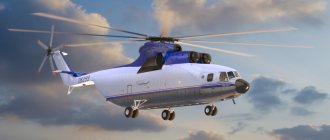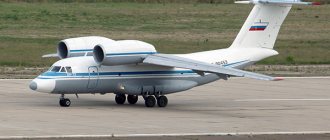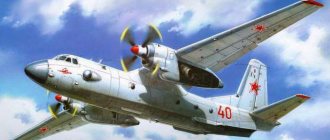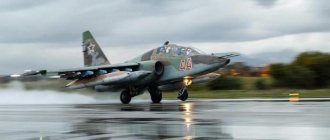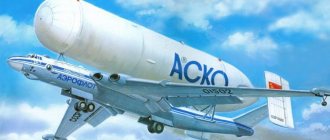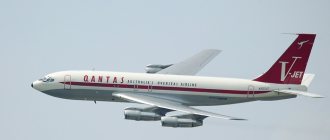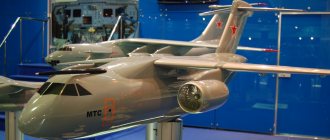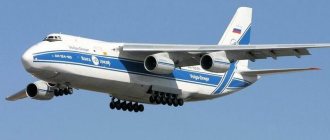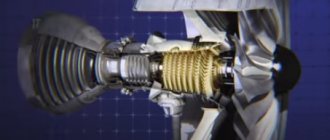Boeing C-17 Globemaster is a strategic American military transport aircraft. It is in service with the Air Forces of the USA, Australia, Qatar, UAE, Canada, Great Britain, India, Kuwait.
Intended for transporting personnel, cargo and dropping cargo from an aircraft.
Developed to replace the cargo version of the Lockheed c-141 Starlifter. The first flight took place on September 15, 1991.
Boeing C-17 Globemaster design
The aircraft was created according to a typical aerodynamic design, consisting of a large-diameter fuselage with a T-shaped tail and a high-mounted wing. The material used to manufacture the airframe is mainly aluminum alloys, the part of composite materials is small - 10-15% (controls, wing end surfaces, fairings and fairings). The airframe is provided with a warranty period of 30 thousand flight hours. The wing has a supercritical profile, sweep - 25°, aspect ratio - 7.2. Dimensions of end aerodynamic surfaces (TAP): height – 2.9 m, area – 3.33 m², sweep – 30°, vertical inclination – 15°.
The wing skin uses 26.82 m long panels - the largest aluminum aircraft components of the late 1980s. The ailerons are made of composite materials. The length of each is 6.4 m, area - 5.9 m², root chord - 1.32 m, end chord - 0.76 m.
The wing mechanism includes slats and double-slit flaps, which are blown by a flow of gases from the engines. They were taken from the experimental YC-15 aircraft and occupy 2/3 of the wing surface area. The flap position can be changed depending on the flight mode. In the reclined position during landing, the aircraft speed is reduced by 46 km/h. On each wing console in front of the flaps there are spoilers in four sections.
The fuselage is made as a semi-monocoque, has a tail section sloping upward with two aerodynamic ridges at the bottom. The cargo compartment has a rear cargo ramp that can accommodate cargo weighing up to 18 tons. The ramp is made up of four sections and is equipped with a hydraulic drive. The angle of its installation depends on the equipment loaded onto the aircraft. The load on the mooring units is 11.3 tf. The nodes are located in the cabin at a distance of 0.61 m from each other. The loading and unloading equipment includes a roller conveyor and rail guides.
The volume of the cargo compartment is designed to transport the M1A1 tank, M2/3 infantry fighting vehicles, trucks weighing 45 tons, SUVs (three in a row), a 155 mm self-propelled artillery mount, up to three AN-64 Apache attack helicopters, up to 18 cargo containers 463L. The aircraft was equipped with 54 folding, non-removable seats intended for transporting military personnel, and is equipped with additional seats (48 pieces) that are stored on board. Mounting for 12 stretchers in the form of racks was installed along the sides of the aircraft.
The Boeing C-17 has an armored lower fuselage that provides protection against small arms fire. The aircraft is designed for non-stop landing of cargo using parachute devices from extremely low altitudes or for landing up to 102 parachutists.
The crew consists of three people: the ship's commander, the second pilot (sitting nearby in the control cabin) and the operator of the loading and unloading equipment (located under the floor of the control cabin on the starboard side). There are places for two observers. You can enter the control cabin through a door with a built-in ladder, which is located on the left side. The cockpit glazing is thick enough to avoid damage from collisions with oncoming birds. The crew rest room is a completely autonomous module, similar to passenger aircraft, located immediately behind the control cabin.
The T-tail has a swept-back stabilizer and fin. Stabilizer area – 79.2 m², span – 19.81 m. Two-section rudder and elevator. The length of the elevator section is 4.45 m. The two-segment rudder has a height of 3.4 m.
The aircraft is equipped with a three-legged retractable landing gear with a hydraulic drive and the possibility of its emergency release. The design of the landing gear elements is designed for landing, during which the descent speed reaches 4.57 m/s, and operation from non-concrete and concrete runways. The front support is two-wheeled, retractable forward. The main supports are six-wheeled and consist of two sequentially located single-axle three-wheeled bogies that are retracted into the fairings on the sides of the fuselage. The aircraft is equipped with a braking system that allows you to stop a car at a speed of 240 km/h, weighing 228 tons, on a road section of 490 m in 14 seconds. Chassis base - 20.05 m, track - 10.27 m.
Boeing C-17 Globemaster
The Boeing C-17's power plant consists of four engines, which are placed on pylons in nacelles under the wings. The F117-PW-100 modular turbofan engine installed on the aircraft is a variant of the PW2040 civil aviation engine. This motor is equipped with a single-stage fan, a four-stage LP compressor, a 12-stage HP compressor, a two-stage HP turbine and a five-stage LP turbine.
There are thrust reversers in flight and on the ground. Gases flow upward during reversal to prevent foreign objects from entering the engines, which could cause structural failure. The power plant is equipped with an electronic engine control system and an active radial clearance control system. The engine has a length of 3.729 m, dry weight - 3220 kg. The Garrett GTCP331 auxiliary power unit is located in the right main landing gear compartment.
The total capacity of the fuel tanks is 102,614 liters. The aircraft is equipped with an in-flight refueling system.
The onboard equipment includes a fly-by-wire digital control system with hydraulic drive from the ailerons of the directional and elevator rudders and a four-channel redundancy circuit. There is an emergency control system with mechanical wiring. On 10/17/1991 there was a case of failure of all EMDS channels, and it was possible to land the device only thanks to the emergency system. The investigation revealed that the cause of the accident was a software failure. By the end of 1992, the EMDS software was changed, providing the ability to switch to fixed gains when the airspeed signal is lost.
The on-board equipment received a new type of control knob. It tilts completely for pitch control and partially with the top for roll control.
The aircraft is equipped with a system to improve controllability and stability. Experimental tests on flights with a high angle of attack showed the need to install an angle of attack limiter. The level of warning signs about reaching dangerous stall parameters with flaps extended also turned out to be insufficient. The problem was eliminated by installing an automatic control lever shaker.
The history of the B-17 Flying Fortress bomber
In 1934, Boeing began developing a heavy bomber under the working name Model 299 , the leading designers of which were E. Emery and E. Wells. The new aircraft was designed according to the technical specifications of the US Army Air Corps and was supposed to become a new word in the history of aviation.
Unlike competitors - Martin and Douglas, which also worked on heavy bombers, Boeing took on the creation of a four-engine bomber, which at that time only two countries - the USSR and France - could boast of possessing. The design and layout were based on the experimental bomber XB-15 , the design of which began a year earlier. The designers incorporated all the most advanced developments into the future B-17 , including an all-metal airframe, a fully enclosed flight deck, retractable landing gear (including a tail wheel), variable pitch propellers, and a bomb bay with electrically controlled bomb bay doors.
On July 7, 1935, the B-17 heavy four-engine bomber prototype was unveiled to the public in Seattle. At the same time, thanks to the light hand of one of the journalists, the famous nickname “Flying Fortress” was firmly assigned to the plane.
On July 28, 1935, the B-17 prototype took off, and in comparative tests with “competitors” Martin B-10B and Douglas DB-1 that began on August 20, it beat them in all respects. However, on August 30, 1935, when the contract for the purchase of the “flying fortress” was practically in Boeing’s pocket, the unexpected happened. The B-17 prototype, Model 299, crashed and was disqualified. The winner of the competition was the Douglas DB-1, which was soon put into production as the B-18 .
B-17 heavy bomber drawing
However, due to the obvious advantage of the Boeing bomber, it was still given a second chance. On January 12, 1936, Boeing was offered to build a series of 13 modified aircraft under the brand name Y1B-17 (“model 299B”) for additional testing. These machines found themselves in a real hellish crucible of testing - they were driven to the tail and mane, they repeatedly slashed the US sky in all directions, visited South America, and in a year they flew 9293 hours without any breakdowns or defects. This was enough to conclude a contract for the supply of 119 first B-17 bombers to the Air Force.
Serial production of “flying fortresses” began in July 1939 and continued until July 29, 1945. The B-17 was produced by (Seattle), Lockheed Vega (Burnbank), and Douglas (Long Beach).
A total of 12,731 B-17 bombers of all modifications were produced. In addition to the US Air Force, it was officially exported to Great Britain, but was also used by other participants in World War II (see B-17 operation below).
Combat use of the Su-17
The first Su-17s began to arrive in units of the USSR Air Force in 1972. During the same period, export deliveries of the aircraft began. In 1970-1971 Designers of the Sukhoi Design Bureau developed an export version of the machine - the Su-20, which began to be delivered to Egypt in 1972. The design of the Su-20 was almost similar to the Su-17M, there were minor differences in the on-board equipment and weapon system of the aircraft.
In 1973, development began on another export modification of the vehicle - the Su-22. The Su-22 received a new R-29BS-300 engine and R-3S and Kh-23 missiles.
The Peruvian Air Force received the first Su-22 aircraft.
From 1973 to 1990, about seven hundred Su-20 and Su-22 modification aircraft were manufactured. They were in service with the allied countries of the Soviet Union under the Warsaw Pact, as well as with states to which the USSR provided military assistance over the years.
The Su-17 and its export modifications Su-20 and Su-22 theoretically had the ability to conduct air combat against Western third-generation fighters, but these machines were almost never used in this capacity. The Su-20 was first used during the 1973 Arab-Israeli conflict. This aircraft was in service with the Syrian and Egyptian air forces. Su-20s attacked Israeli military and industrial targets. During the fighting, 12 Su-20s were lost.
The second campaign in which the Su-17 was used (this time a modification of the Su-22) was the war in Lebanon in 1983. Its use was very unsuccessful: during one combat mission (ten aircraft), seven aircraft were shot down.
The Su-17 was very actively used during the Afghan war, it became the only Soviet aircraft that went through this campaign from its beginning to the end. The Su-17 was used as a bomber, attack aircraft and reconnaissance aircraft. In addition, this vehicle, in the Su-20 and Su-22 modifications, became the basis of the Afghan Air Force. During this conflict, about thirty vehicles were lost (there are no exact data). Several aircraft of export modifications (Su-20 and Su-22) were shot down by Pakistani Air Force fighters. One Su-22 was hijacked by an Afghan pilot to Pakistan. Several Su-22s fell into the hands of the Taliban after they seized power in the country. Later, all Taliban aircraft were destroyed by the Americans at the airfields.
The Su-20 and Su-22 were the main aircraft of the Iraqi Air Force during the Iran-Iraq War. The total losses of these aircraft during this campaign amount to more than sixty aircraft.
During the first Gulf War, Iraq transferred 44 Su-20s to Iran to protect them from attacks by international coalition aircraft. After the end of the war, the Iranian authorities refused to return the planes to their rightful owner.
The Su-17 was used by the Angolan Air Force during the civil conflict against UNITA partisans.
The Libyan Air Force used these vehicles to attack rebel forces during the early stages of the civil war.
The Yemeni Air Force used Su-17s against Shiite rebels.
Currently, the Syrian Air Force is using the Su-17 to launch missile and bomb attacks on rebel positions. At least five vehicles are known to be lost. At the beginning of September 2022, a Syrian Air Force Su-22M4 was shot down near the village of Deir ez-Zor. The pilot died.
B-17 Flying Fortress bomber design
The B-17 heavy bomber is built according to the aerodynamic design of a free-carrying low-wing aircraft. All-metal construction, round fuselage of semi-monocoque type.
The wing is trapezoidal in plan with a sweep of 8°9′ along the leading edge. The center section is three-spar, the consoles are two-spar. The wing mechanization consisted of ailerons and landing flaps. The fin is manufactured integrally with the fuselage. Starting with the modification of the B-17E, a fork was installed. The leading edges of the wing and fin are occupied by a rubber deicer.
The landing gear is retractable, tricycle, with a tail wheel. The power plant consisted of 4 piston 9-cylinder radial air-cooled Wright R-1820 engines with General Electric B-2 superchargers (on the B-17G - B-22) and three-bladed variable-pitch propellers with a diameter of 3.53 m. The engines were covered with NASA cowlings .
The bomb load was located in a bomb bay in the central part of the fuselage. Some modifications could use depth and guided bombs. If necessary, 2 additional fuel tanks could be installed in the bomb bay. Defensive weapons varied depending on the modification and consisted of 7.62 and 12.7 mm machine guns. The crew members were protected by armored plates, armored seat backs, and the gunners were also protected by armored aprons.
Interior of a B-17 bomber
The crew of the “fortress” consists of 10 people and includes:
- ship commander
- co-pilot
- navigator (at the same time - bow turret gunner)
- bombardier (at the same time - bow turret gunner)
- flight engineer (at the same time - upper turret gunner)
- radio operator gunner
- arrow of the lower (ventral) turret
- side gun (left)
- side gun (right)
- tail turret arrow.
Modifications of the B-17 Flying Fortress bomber
- "Model 299" - the first prototype with Pratt-Whitney R-1690-E engines producing 750 hp. First flight July 28, 1935.
- Y1B-17 (“model 299B”) - pre-production, with a modified chassis design, Wright R-1820-39 engines with 850 hp, increased fuel capacity, and an anti-icing system. In 1936, 13 aircraft were manufactured.
- Y1B-17A (“model 299F”) - experimental with R-1820-51 turbocharged engines. Converted from an airframe for static testing. First flight April 29, 1938.
- The B-17B is the first production version. The main innovations are the presence of turbochargers on the engines, a modified fuel system, a larger rudder, and a shorter forward fuselage. The crew included a bombardier and a navigator separately. From July 1939 to March 1940, 39 aircraft were manufactured.
- B-17C (“model 299H”) - with R-1820-65 engines. It was distinguished by the absence of blisters for firing points. From September 1939 to October 1940, 18 aircraft were manufactured for the US Air Force.
Characteristics of the Boeing B-17
A country:USAType:Heavy bomberYear of issue:1936Crew:8 peopleEngine:4x R-1820-65, 850 hp eachMaximum speed:507 km/hPractical ceiling:11200 mRange of flight:3200 km (5280 km - ferry)Empty weight:14650 kgMaximum take-off weight:24100 kg (18300 - normal takeoff)Wingspan:31.64 mLength:23.51 mHeight:5.85 mWing area:132.1 sq.m.Weapons:1x 7.62 mm machine gun, 8x 12.7 mm machine guns, up to 7000 kg bomb load
Specifications for the B-17E are given.
- B-17D - modified, with louvers on the engine cowlings, protected tanks, new bomb racks, additional armor, coaxial machine guns in the upper and lower firing points, and a modified oxygen system. In February-April 1941, 42 aircraft were manufactured. Some previously released B-17Cs were modified in the field to resemble the B-17D.
- B-17E (“Fortress IIA”) - modernized. It was distinguished by a new tail section of the fuselage, enlarged vertical and horizontal tail surfaces, reinforced defensive weapons, and armor protection for the crew's workplaces. Developed since August 1940. From September 1941 to May 1942, 512 aircraft were manufactured. 45 aircraft were transferred to Great Britain.
- B-17F (“model 299O”, “Fortress II”) - modified, with uprated R-1820-97 engines with a power of 1000 hp, wide-bladed propellers, enhanced armor protection, a glazed nose made of a single piece of plexiglass, protected oil tanks, additional bomb racks under the wing, reinforced chassis. From June 1942 to September 1943, 3405 aircraft were manufactured. 19 aircraft were delivered to the UK.
- B-17F-VE, B-17F-DL - carriers of gliding radio-controlled bombs. Produced at Burnbank and Douglas in Long Beach.
- B-17G (“Fortress III”) - modified, with a Bendix upper turret. Some aircraft were equipped with the British H2X radar bomb sight. Since September 4, 1943, three factories have produced 8,680 aircraft (the most massive modification). 85 aircraft were delivered to the UK. B-17G-50-BO - with onboard turrets spaced along the length of the aircraft.
- B-17G-45-DL, B-17G-55VE, B-17G-80-BO - with a Cheyenne tail turret.
- B-17G-75-DL, B-17G-85VE, B-17G-105-BO - without radio operator’s machine gun.
B-17 in the air, open bomb bay visible
- BQ-7 "Castor" - a radio-controlled projectile aircraft, with 10 tons of explosives on board. In 1944, 25 B-17Es and B-17Fs were converted.
- S-108 is a staff aircraft without weapons. Several B-17Fs and B-17Fs were converted.
- The CB-17 is an unarmed transport aircraft. Several early production aircraft have been converted.
- DB-17P - target control aircraft.
- F-9 - reconnaissance aircraft with cameras in the bomb bay and in the radio operator's cabin. 16 B-17Fs converted.
- F-9A - reconnaissance aircraft, differed in the composition of its equipment.
- F-9B - reconnaissance aircraft, differed in the composition of its equipment.
- F-9C (RB-17G) - reconnaissance aircraft based on the B-17G. Cameras were placed under the cabin, instead of machine guns. 10 aircraft were converted.
- The F-19 is a passenger aircraft with 14 seats. In 1944-1945, SAAB (Sweden) converted 5 aircraft.
- Fortress I (Model 299T) is an export version of the B-17C. It was distinguished by the composition of its equipment and its protected fuel tanks. 20 aircraft were manufactured for Great Britain.
- PB-1 is a patrol and rescue aircraft. 46 B-17Gs and 2 B-17Fs were converted for the US Navy.
- PB-1G - patrol. It was distinguished by the presence of a radar with an antenna in the nose cone. Some of the planes carried rescue boats. Several aircraft were operated by the US Coast Guard until 1959.
- PB-1W is a radar patrol aircraft with AN/APS-20 radar. The Navy's Jonesville facility converted 31 B-17Gs.
- QB-17L is a target with a television control system. After the war, aircraft that had exhausted their service life were refurbished. The last QB-17L was shot down in August 1959.
- QB-17N is a radio controlled target.
- VB-17G is a staff aircraft.
- XB-40 (V-139-3) is a typical heavy escort fighter (“air cruiser”). Developed from the B-17F. It was distinguished by an additional Martin-250 turret in the forward part of the fuselage, twin machine guns in on-board installations, increased ammunition capacity (11,275 rounds), and enhanced armor protection.
- YB-40 (V-139-3) - serial “air cruiser”. In 1943, 22 B-17F bombers were converted. Used in Europe from May to August 1943.
- XС-108 is a prototype of a staff aircraft. Later, General Douglas MacArthur flew on it, especially for whom machine guns with chrome-plated barrels were installed and curtains were hung on the windows.
- XC-108A is a transport vehicle, with a large cargo hatch on the left side and a side-hinged bow.
- XС-108B - tanker. 1 aircraft was converted.
- XPB-1 is a flying laboratory for testing turbojet engines.
The raids typically involved dozens of B-17 bombers. Considering that each of these masses had at least 8 heavy machine guns, approaching such a formation was a real test for an enemy fighter. This is a real fortress!
Design Features
When creating the C-17 model air transport, a conventional aerodynamic design was used. The finished technology included a fuselage equipped with a T-shaped tail and a high-lifted wing.
Aluminum alloys and approximately 15% composite materials were used to make the body . A high-strength base was used to make the end part of the wing, fairings and controls. The service life of the aircraft, according to aircraft manufacturers, should have exceeded 30,000 flight hours.
The designers made the fuselage in accordance with the semi-monocoque type, which made it possible to create a beveled tail section and equip the aircraft with 2 aerodynamic ridges. The rear cargo ramp was located in the cargo compartment. A reliable ramp can easily withstand quite a significant load, the weight of which can exceed 18 tons .
